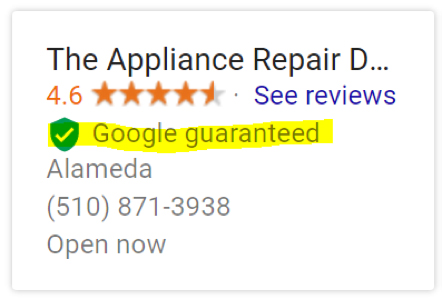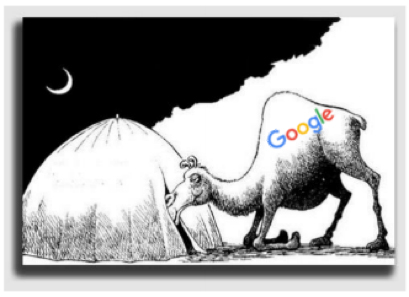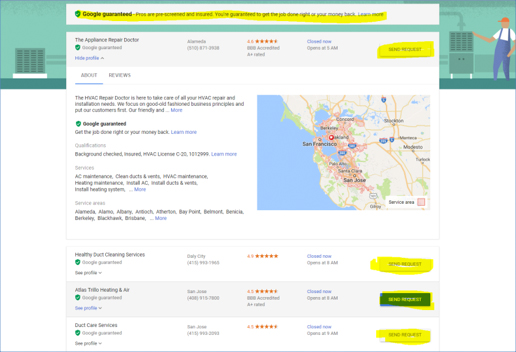Just when you thought you had Local Search figured out—Google brings out a new game board
Note: Since this article was first published, Google has changed ‘Google Home Services’ to ‘Google Local Services’ due to the fact that all service industries they plan to include are not necessarily home services.
Brace yourself— Google is in the process of “changing the game board” again when it comes to generating leads through local search. For almost three years in the bay area of San Francisco, Google had been experimenting testing different approaches to directly compete against HomeAdvisor and Angie’s List, and getting into the ‘lead-selling’ business. Unlike AdWords, where you are just buying ad space and the transaction is directly between you and the consumer, Google’s new Home Services division wants to be the new ‘broker’ and ‘quality police’ of the entire transaction. In other words, like HomeAdvisor and Angie’s List, they want to become the gatekeeper between you and new customers. The scary news is that they will probably be very successful in doing it—especially with how they have structured their new program.
Currently, Google is in the process of rolling out their new program in seven major cities around the country.The cities are Phoenix, Atlanta, Philadelphia, Seattle, San Diego, Baltimore, and Los Angeles.For your consideration, in this article I will go over how their new program works, what has changed that may have caused them to initiate the rollout now, and my analysis of the potential long – term repercussions.
Welcome to Google Home Services— and the ‘Google Guaranteed’ program
After watching Google over the last few years try to make its Home Services platform work (which is a good amount of time for Google to test anything), I was surprised when I learned a little over a month ago that it was breaking out of California and expanding to new cities around the country. What I wanted to know was, what had they changed in the program that made them decide their program was a winner? It may be because they want to beat the new HomeAdvisor merger with Angie’s List that will culminate in December, but I was curious as to what the final version looked like. Finding the answer to that question has been surprisingly difficult, since Google has kept a tight lid on what they are doing. Obtaining preliminary information on their new program has taken a good amount of time and effort to say the least—but here’s how the program is being rolled out today.
To start with, notice the image to the right that shows the results for the search “AC repair San Francisco”. If you want to try this search on your computer, make sure you’re logged out of Google or you won’t see the same results (Google’s version of “move along… these aren’t the droids you’re looking for). At the top of the page, under the heading “AC repair – HVAC pros serving San Francisco” you see three boxes, with each box listing a contractor, their Google review count, and then the fact that they are “Google guaranteed”—which I also highlighted in yellow. Below this is a phone number and the hours when they will be open if they are not currently open.
It’s important to note that the phone number they show is not the contractor’s number, but a recorded tracking number assigned to them by Google. Should the number be used by a consumer, the number displayed will change in the listing, and the number the consumer used to call you will remain active for that consumer for the next 15 days. The consumer’s call will display to you as a Google-forwarded number—not the consumer’s actual number. As long as you’ve spoken to the customer in the past 15 days, you can continue to stay in touch using the Google-forwarded number. The unspoken part here is, should you ask the customer for their direct number to try to circumvent Google recording your communication, you may find yourself out of their program… oh, and did I already mention that Google wants to be the gatekeeper of the transaction?
The good news (if you want to see it as that) is that Google only keeps total control of the customer’s contact information for 15 days from the last contact. If you haven’t spoken to that customer in the past 15 days, the consumer’s forwarding number will be deactivated, and their real number will display in your Home Service app dashboard. This way, you’ll be able to retain their real contact information beyond the initial call.
When the consumer clicks on one of the contractors in the Google Home Service results, the next screen that appears (shown at right) provides additional information on their chosen contractor, as well as a list of all the other participating contractors in the program. It also presents the customer with a “SEND REQUEST” button where the consumer can senda service request to their chosen contractor—as well as other contractors on the list, all at the same time. Just like HomeAdvisor and Angie’s List, Google realized that, unlike its AdWords program, the only thing better than selling a lead once, was getting to sell the same lead multiple times to different contractors.
Currently, in the market I am familiar with, the cost of a lead is based on a flat fee of about $25 dollars per lead. Before you get too excited about that price, be aware that you will be potentially competing with other contractors for the same lead. If a customer chooses three of you, and you all have an equal success rate, the cost per sold lead is now $75. However, I suspect that the current rate is more of an
introductory rate, since Google was built on maximizing revenue with all their products. Once the program is established and demand for the program increases, I fully expect it to evolve into a bid system similar to AdWords.
As I mentioned earlier, Google Home Services had been operating for almost three years in the San Francisco bay area and then, just recently, in Los Angeles. During this time, they have changed how the program was presented quite a bit in order to test different approaches to making the program work. With all the changes being made, the assumption was that the program wasn’t performing like they wanted. However, about 3-4 months ago, they came out with a new program called ‘Google Guarantee’. Maybe it’s just coincidental, but within two months of releasing this new program, Google’s Home Services program expanded to major cities all over the country.
So, what is the ‘Google Guarantee’?
At the top of the list of contractors that clicking on a Google Home Service ad brings up, you find the following sentence.

“Google guaranteed – Pros are pre-screened and insured. You’re guaranteed to get the job done right or your money back. Learn more”
When the consumer clicks on “Learn more”, Google explains their guarantee this way; “If you’re not satisfied with the work quality, we’ll cover claims up to the job invoice amount, with a lifetime cap of $2,000. Your job must be booked through Home Services. Add-on or future projects, damages to property, dissatisfaction with price or provider responsiveness, and cancellations aren’t covered.” So, if you don’t already have a money-back quality guarantee on the quality of your service—you will have one through Google if you participate in their program.
To cash-in on the Google guarantee, customers have 30 days after the job is done to file a claim if they are unsatisfied with the quality of the work performed. As far as exclusions to the guarantee, Google states, “add-on or future projects; damages to property; dissatisfaction with price or provider responsiveness; and cancellations are not covered.”
Getting Involved with Google Home Services
Like AdWords, you pay only for leads from customers who click on your listing, and your listing will only show up when you have money left in your weekly budget. Unlike AdWords, which is strictly a ‘pay-to-play’ marketing transaction that anyone can participate with, Google now has some exposure in the actual work performed due to their guarantee. Because of this, participation in the program is by invitation only and is based on your online reputation (reviews) and passing a background check. Since Google likes to stay internal for its data as much as possible (they definitely have real trust issues), the assumption is that your reputation is being measured heavily by your actual Google reviews.
However, a Google representative revealed to us something that is important to note: once in the program, the reviews and star rankings that they will show clients are specific to Google Home Services, and different from your regular Google reviews. They are generated within their app/platform and stay with the platform, meaning you lose them should you leave the program.
Below is how Google now screens the contractors they are choosing:
Background checks include inquiries about the validity of each provider’s Social Security number and criminal history (including cross-checks against national sex offender, terrorist, and sanctions registries). In addition, each provider’s company is checked for applicable trade licenses, insurance, and civil litigation history (including judgments & liens from federal and state courts).
You can read more about the requirements in our policy center.
Google encourages you to review each provider’s profile to learn more about the business-level licenses it has reviewed.
Also, Google continues to collect ratings and reviews from people who hired Home Service providers. As described in our Policy Center, serious or repeatedly negative customer feedback may result in lower rankings (including not showing at all).
To answer the obvious question I know you’re dying to ask, so far, Google is covering the entire costs of all the initial background checks. To stay in the program, you will be required to recertify your approval every three months to keep the information accurate. Recertification will require you to attest that:
- You haven’t hired any new workers during the last reporting period who will perform services in customer’s homes or workplaces referred through Google’s Home Service ad platform.
- Every worker you are sending to customers’ homes and workplaces are the same workers who were originally background-checked and approved.
- There are no circumstances (of your company or your workers) that could change the outcome of the previous background check approval.
How Google Home Services can Affect You
No matter what you think of all the third-party services out there that want to broker leads, Google is different. Personally, I think their decision to offer the Google guarantee is brilliant and a potential game-changer. My biggest question is who the real winner of their new game will be, because I’m not very sure it will be the contractor. From a marketing standpoint, many companies like mine already offer money-back guarantees that are better and stronger than what Google is offering—but what we don’t have is the appearance of a benevolent third-party arbitrator that Google’s program will appear to the customer to be. As a consumer, if you’re unhappy with a company, do you want to try to collect from the company you’re angry at, or would you rather just deal with a seemingly neutral third party and let them deal with it? That fact alone makes their guarantee more powerful than anything you or I can offer independently.
The beauty of Google’s program is that the risk they really carry is little to none. Even though Google says that the contractor is not liable for any claim submitted for reimbursement through the Google guarantee program—the operational reality will be quite different. You see, although you aren’t liable to refund the cost of the job, Google states in its guidelines on How pros qualify for Home Service ads that:
“…serious or repeatedly negative customer feedback may result in lower rankings ?(including not showing at all).”

I’m sure it’s not very hard to “read between the lines” of the above statement, but I’ll spell it out anyway. I expect paying out $2,000 on a contractor’s behalf probably qualifies under the ‘serious negative customer feedback’ category. So, if the program is successful, and you are getting profitable leads… do you give the customer their money back… or do you let Google do it and risk getting kicked out of the program? My guess is that you will be the one entirely underwriting the Google guarantee, and Google will end up just being the big gorilla looking over your shoulder. Personally, I don’t really see this part of the program as a major negative since most good companies already have money-back guarantees that they honor.
In the short-term, getting involved in Google Home Services is probably a good business choice if you get invited to do so. Unlike HomeAdvisor, YELP, and Angie’s List… they are all playing in Google’s Sandbox—Google is not playing in theirs. Adding their Home Services to the top of a local search results page not only gives them the prime spot, it also pushes down the ads and organic results that all the other referral sites depend on for traffic. Unfortunately, the parts being pushed down further are also where you currently get your leads from search as well.
My concern with Google’s Home Service program is not in the short term, but in the long game. If you do get involved in it, I have little doubt it will be successful and you will make money—at least initially. In fact, it is good companies getting involved in it that will make it succeed and become fully adopted by the general public. However, be aware that once it is fully accepted by the public, you better have a “Plan B” for generating service calls that takes into consideration the potential monster we all helped to create when the laws of economics finally kick in.
The problem Google’s Home Services money-back quality guarantee creates for contractors is that it totally removes any consequences from a consumer’s choice. In economics, potential consequences that affect decisions are referred to as economic friction. Economic friction is anything that influences a consumer’s decision other than price—and there’s the rub. You see, if Google says everyone on the page is great… has all appropriate licenses… has great employees that have passed background checks… gets great reviews from everyone… and Google will give you money back if they screw up… what do you think the deciding factor for who gets the job will be? Have no doubt, the decision will be determined by price. Oh… and did I mention that Google allows you to put pricing in their Home Service Ads so comparison shopping will probably become even easier?
Simple economics tells you that, all things being equal, price will always decide. You don’t have to look hard to realize that Google’s new program is designed to create the illusion that all contractors are equal in their program. So, unfortunately, it can’t help but be a race to the bottom price with the winner being the one who has the most efficient operation and is able to profitably deliver quality at the lowest price. Unfortunately, this may not even be a great strategy since our industry has a track record of people who are good, conscientious tradesman who blissfully sell below their true costs—until they finally go bankrupt and two more step in to fill their spot.
For now, my advice to my clients is that, unless something else comes up that changes things, do what it takes to get invited to play. I have little doubt that the initial ROI will be great for the contractors who get invited. However, be aware that, overall, the economics of the model suggest that it will probably gravitate to favor smaller, price-driven companies that take pride in their work, but either ignore or personally absorb their full overhead costs. The fact that the dashboard is heavily slanted to mobile use, which is perfect for the smaller contractor or the technician striking out on his own, makes me suspect that Google sees it going this way as well. However, in the long run, be aware that when it no longer becomes economically viable to stay with the program, it will still be taking a lot of potential customers out of the repair market that you will have to find a way to replace.

If you think I’m being overly pessimistic on the program, I hope you’re right. However, my goal is to try to provide a long-term perspective and potential ‘trajectory’ of Google’s new Home Services program, to help my clients plan accordingly. In this case, the “If I don’t, my competitor will!” rationale to get involved is probably very sound reasoning until other options become available. However, there are always unintended consequences that come with every decision. From an economic perspective it’s potentially a short window of opportunity to make money until it gets fully established and price becomes the sole focus.
In closing, my biggest concern is that at no other time in our industry’s history has such a dominant market force made it their goal to insert themselves between us and our customer. I can’t help but think of the story about the ‘Bedouin and the Camel’. In the story, it’s the last sentence that concerns me the most. “…when the Bedouin woke up the next morning, he was outside in the cold and the camel had the tent to himself.”
—dave
Please address all comments or questions regarding this or any other articles in our newsletter to articles@online-access.com.


